Design and Parameters Optimization of a Provoke-Suction Type Harvester for Ground Jujube Fruit
Abstract
:1. Introduction
2. Materials and Methods
2.1. Structure of the PSH
2.2. Working Principle
2.3. Operating Conditions and Main Technical Parameters
2.4. Parameters Analysis and Device Design
2.4.1. Critical Velocity
2.4.2. Design of the Pickup Device
- (1)
- Pickup Device Structure
- (2)
- Depth of the Provoking Teeth into Soil
- (3)
- Space between the Provoke Teeth
- (4)
- Angle between the Provoke Teeth and Ground
2.4.3. Design of the Cleaning Device
2.5. Test Materials
2.6. Test Methods
3. Results and Discussion
3.1. Pickup Rate
3.2. Impurities Rate
3.3. Working Efficiency
3.4. Parameter Optimization
3.5. Discussion
4. Conclusions
Author Contributions
Funding
Institutional Review Board Statement
Informed Consent Statement
Data Availability Statement
Conflicts of Interest
References
- Editorial Committee of China Agricultural Yearbook. China Agricultural Yearbook 2019; Agriculture Press: Beijing, China, 2020. [Google Scholar]
- Ji, X.; Peng, Q.; Yuan, Y.; Shen, J.; Xie, X.; Wang, M. Isolation, structures and bioactivities of the polysaccharides from jujube fruit (Ziziphus jujuba Mill.): A review. Food Chem. 2017, 227, 349–357. [Google Scholar] [CrossRef]
- Zhang, S.; Li, N. Effects of carbon monoxide on quality, nutrients and antioxidant activity of post-harvest jujube. J. Sci. Food Agric. 2013, 94, 1013–1019. [Google Scholar] [CrossRef]
- Lu, H.; Lou, H.; Zheng, H.; Hu, Y.; Li, Y. Nondestructive Evaluation of Quality Changes and the Optimum Time for Harvesting During Jujube (Zizyphus jujuba Mill. cv. Changhong) Fruits Development. Food Bioprocess Technol. 2011, 5, 2586–2595. [Google Scholar] [CrossRef]
- Hu, Y.; Bai, B.; Wang, W. Prent development situation of red jujube industry in Xinjiang and relative countermeasures and suggeation. Xinjiang Agric. Mech. 2016, 6, 21–24. [Google Scholar]
- Stephan, H. Automation in Agriculture—Securing Food Supplies for Future Generations; IntechOpen: London, UK, 2018; pp. 81–105. [Google Scholar]
- Kootstra, G.; Wang, X.; Blok, P.M.; Hemming, J.; van Henten, E. Selective Harvesting Robotics: Current Research, Trends, and Future Directions. Curr. Robot. Rep. 2021, 2, 95–104. [Google Scholar] [CrossRef]
- Zhou, Y.; Kan, Z.; Li, C.; Zhang, H.; Fu, W.; Cui, J. The research and Development of The Falling Tree Fruits and Nuts Collect and Pick-up Technology. J. Agric. Mech. Res. 2017, 39, 256–263. [Google Scholar]
- Zhang, Y.; Kan, Z.; Li, C.; Fu, W.; Wang, L.; Li, L. Design of Dwarf and Close Planting Jujube Harvester Pickup Device. J. Agric. Mech. Res. 2016, 38, 71–75. [Google Scholar]
- Fu, W.; Zhang, Z.; Ding, K.; Cao, W.; Kan, Z.; Pan, J.; Liu, Y. Design and test of 4ZZ-4A2 full-hydraulic self-propelled jujube harvester. Int. J. Agric. Biol. Eng. 2018, 11, 98–104. [Google Scholar] [CrossRef]
- Lu, B. Design and Experimental Study of Electric Self-Propelled Ground Jujube Harvester by Cleaning and Collecting; Tarim University: Xingjiang, China, 2014. [Google Scholar]
- Li, C.; He, X.; Xu, R.; Wang, J.; Yi, X.; Lü, X. The design of the roller type jujube collecting machine. Food Ind. 2017, 38, 211–213. [Google Scholar]
- Zhang, X.; Bai, S.; Jin, W.; Yuan, P.; Yu, M.; Yan, J.; Zhang, C. Development of pneumatic collecting machine of red jujube in dwarfing and closer cultivation. Trans. Chin. Soc. Agric. Eng. 2019, 35, 1–9. [Google Scholar]
- Pan, J. The Design and Experimental Research of Air blow Type Ground Jujube Picking Device; ShiHezi University: ShiHezi, China, 2018. [Google Scholar]
- Zhang, F.; Yu, F.; Li, Z.; Zhang, H.; Lan, H.; Li, P.; Zhang, C. Design and test of the air suction machine for picking jujube. J. Fruit Sci. 2020, 37, 278–285. [Google Scholar]
- Shi, G.; Ma, S. Design and Experiment of Air-suction Red Dates Picking Machinery. Agric. Eng. 2014, 4, 109–112. [Google Scholar]
- Sun, M.Y. Optimization of Structural Parameters and Test Analysis of Gas Suction Type Machine for Pick Up the Red Jujube; Tarim University: Xingjiang, China, 2016. [Google Scholar]
- Bora, G.C.; Ehsani, R. Evaluation of a Self-Propelled Citrus Fruit Pick-Up Machine. Appl. Eng. Agric. 2009, 25, 863–868. [Google Scholar] [CrossRef]
- Pagano, M.; Fanigliulo, R.; Tomasone, R.; Cedrola, C.; Recchi, P.; Colorio, G. Mechanical Hazelnut Harvesting: First Results of a Pickup Prototype for a Low Environmental Impact. Acta Hortic. 2011, 919, 139–146. [Google Scholar] [CrossRef]
- Sanders, K. Orange Harvesting Systems Review. Biosyst. Eng. 2005, 90, 115–125. [Google Scholar] [CrossRef]
- Zhang, X.; Bai, S.; Jin, W.; Yu, M.; Yan, J.; Zhang, C. Experimental study on characteristics of jujube material in dwarf dense planting mode. J. Chin. Agric. Mech. 2019, 40, 68–72. [Google Scholar]
- Yu, F.; Li, P.; Zhang, F.; Zhang, H.; Li, Z.; Fan, X. Experiment Determination and Analysis of Suspension Velocity Characteristic for Red Jujube. J. Chin. Agric. Mech. 2020, 41, 89–94. [Google Scholar]
- Li, B. Agricultural Mechanics; China Agriculture Press: Beijing, China, 2003. [Google Scholar]
- Mahawar, M.K.; Bibwe, B.; Jalgaonkar, K.; Ghodki, B.M. Mass modeling of kinnow mandarin based on some physical attributes. J. Food Process Eng. 2019, 42, e13079. [Google Scholar] [CrossRef]
- Chinese Academy of Agricultural Mechanization Sciences. Agricultural Machinery Design Manual (Volume 2); Agricultural Science and Technology Press: Beijing, China, 2007. [Google Scholar]
- Azimi, S.; Chegini, G.; Kianmehr, M.H. Design and manufacture of safflower petal harvester machine. Mech. Ind. 2012, 13, 301–305. [Google Scholar] [CrossRef]
- Dasani, D.; Cyrus, C.; Scanlon, K.; Du, R.; Rupp, K.; Henthorn, K.H. Effect of particle and fluid properties on the pickup velocity of fine particles. Powder Technol. 2009, 196, 237–240. [Google Scholar] [CrossRef]
- Kim, K.-Y.; Samad, A.; Benini, E. Fluid Mechanics and Computational Fluid Dynamics; Wiley: Hoboken, NJ, USA, 2019; pp. 11–33. [Google Scholar]
- Dai, F.; Song, X.; Zhao, W.; Han, Z.; Zhang, F.; Zhang, S. Motion simulation and test on threshed grains in tapered threshing and transmission device for plot wheat breeding based on CFD-DEM. Int. J. Agric. Biol. Eng. 2019, 12, 66–73. [Google Scholar] [CrossRef] [Green Version]
- Shi, Y.; Wang, X.; Hu, Z.; Gu, F.; Wu, F.; Chen, Y. Optimization and experiment on key structural parameters of no-tillage planter with straw-smashing and strip-mulching. Int. J. Agric. Biol. Eng. 2021, 14, 91–96. [Google Scholar] [CrossRef]
- DG/T 188-2019 “Fruit Picker”. Available online: https://www.csres.com/notice/53315.html (accessed on 3 December 2019).
- Manson, A. Response Surface Methodology. Technometrics 2008, 15, 936–938. [Google Scholar] [CrossRef]
- Xu, H.; Tian, D.; Liu, J.; Niu, Z.; Li, Q. Operation analysis and parameter optimization of drum type soil-covering device. Int. J. Agric. Biol. Eng. 2021, 14, 106–111. [Google Scholar] [CrossRef]
- Dai, Z.; Wu, M.; Fang, Z.; Qu, Y. Design and Parameter Optimization of Fruit–Soil Separation Device of Lily Harvester. Agric. 2022, 12, 175. [Google Scholar] [CrossRef]
- Wu, B.; Men, J.; Chen, J. Numerical study on particle removal performance of pickup head for a street vacuum sweeper. Powder Technol. 2010, 200, 16–24. [Google Scholar] [CrossRef]

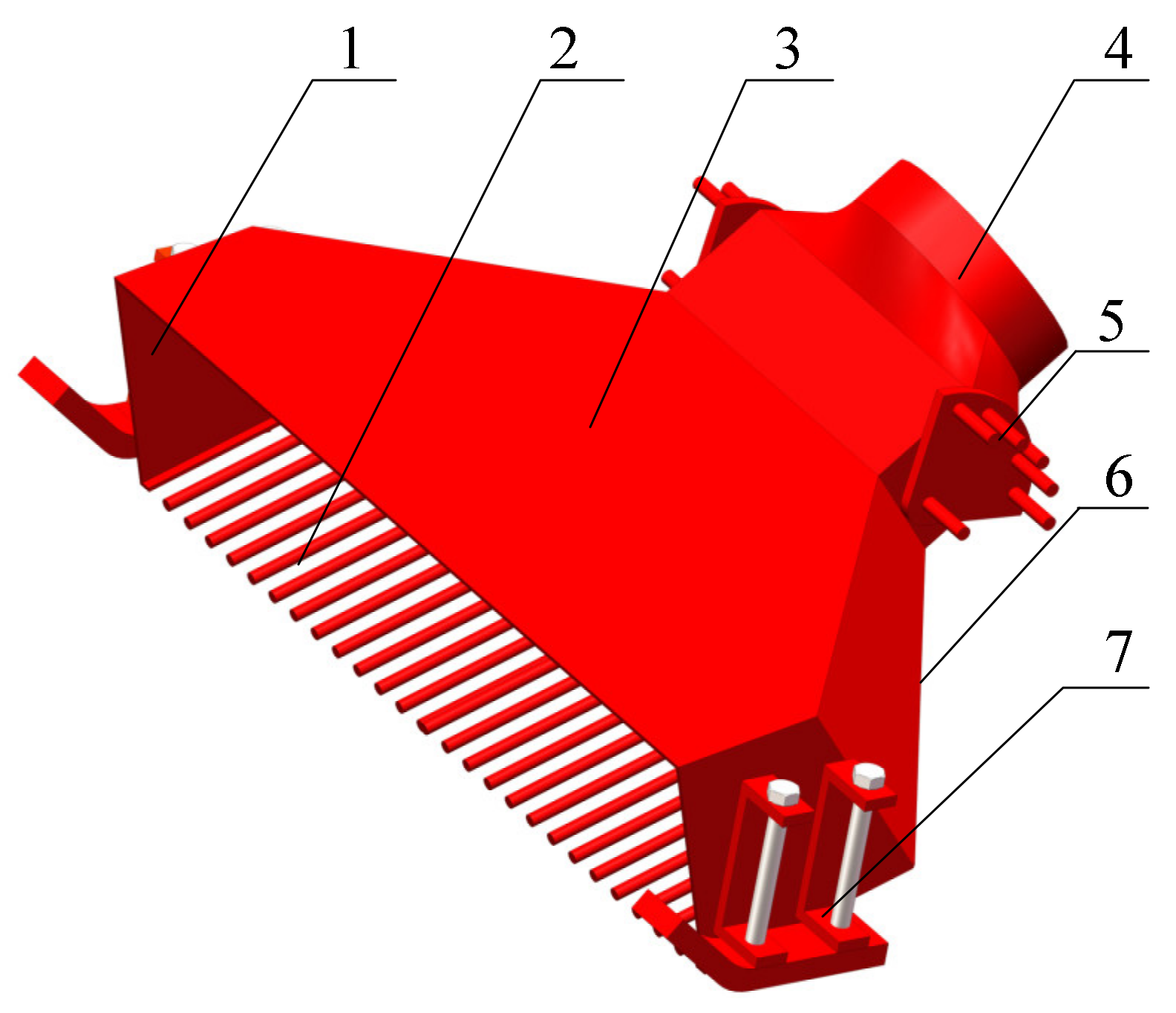


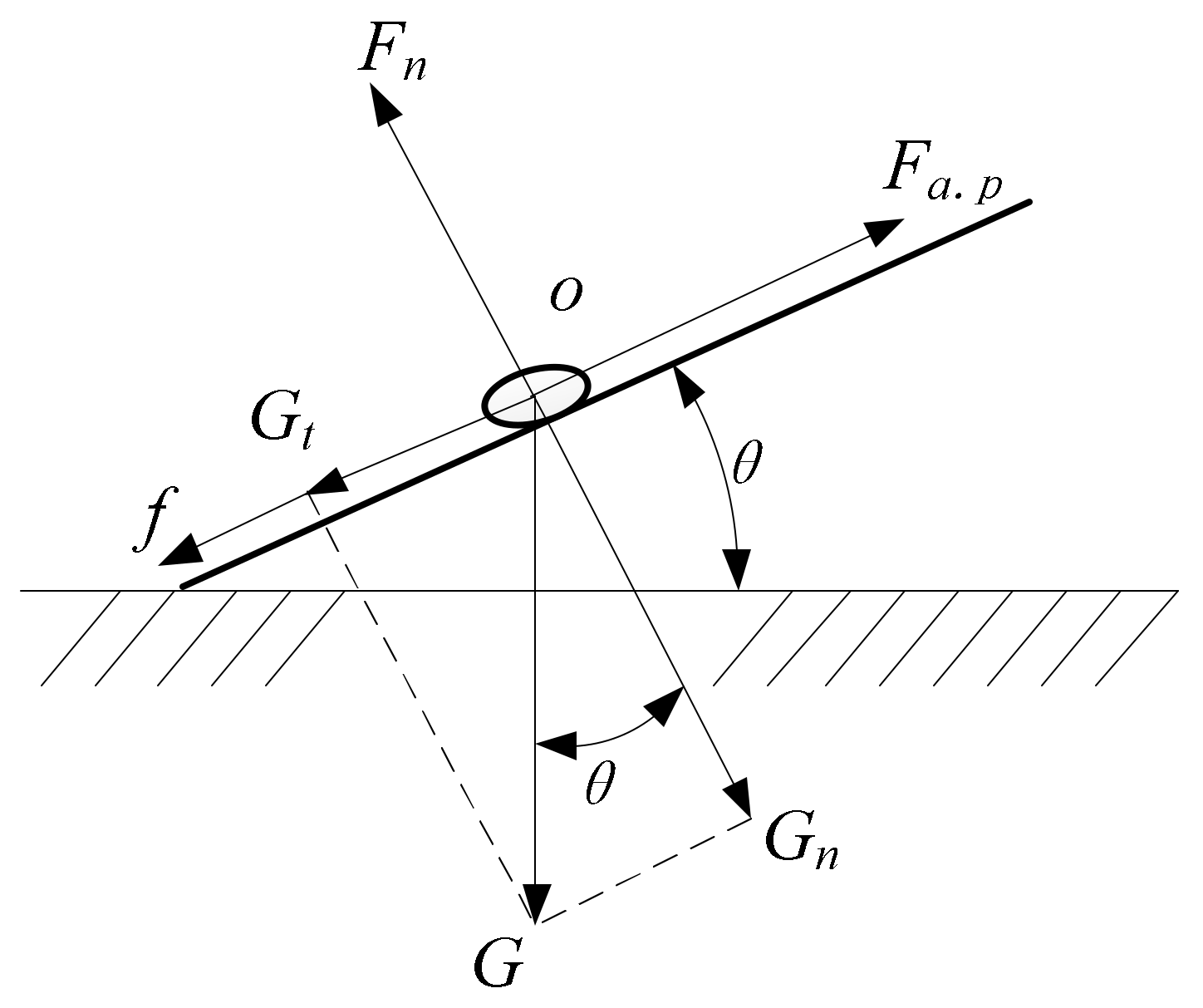
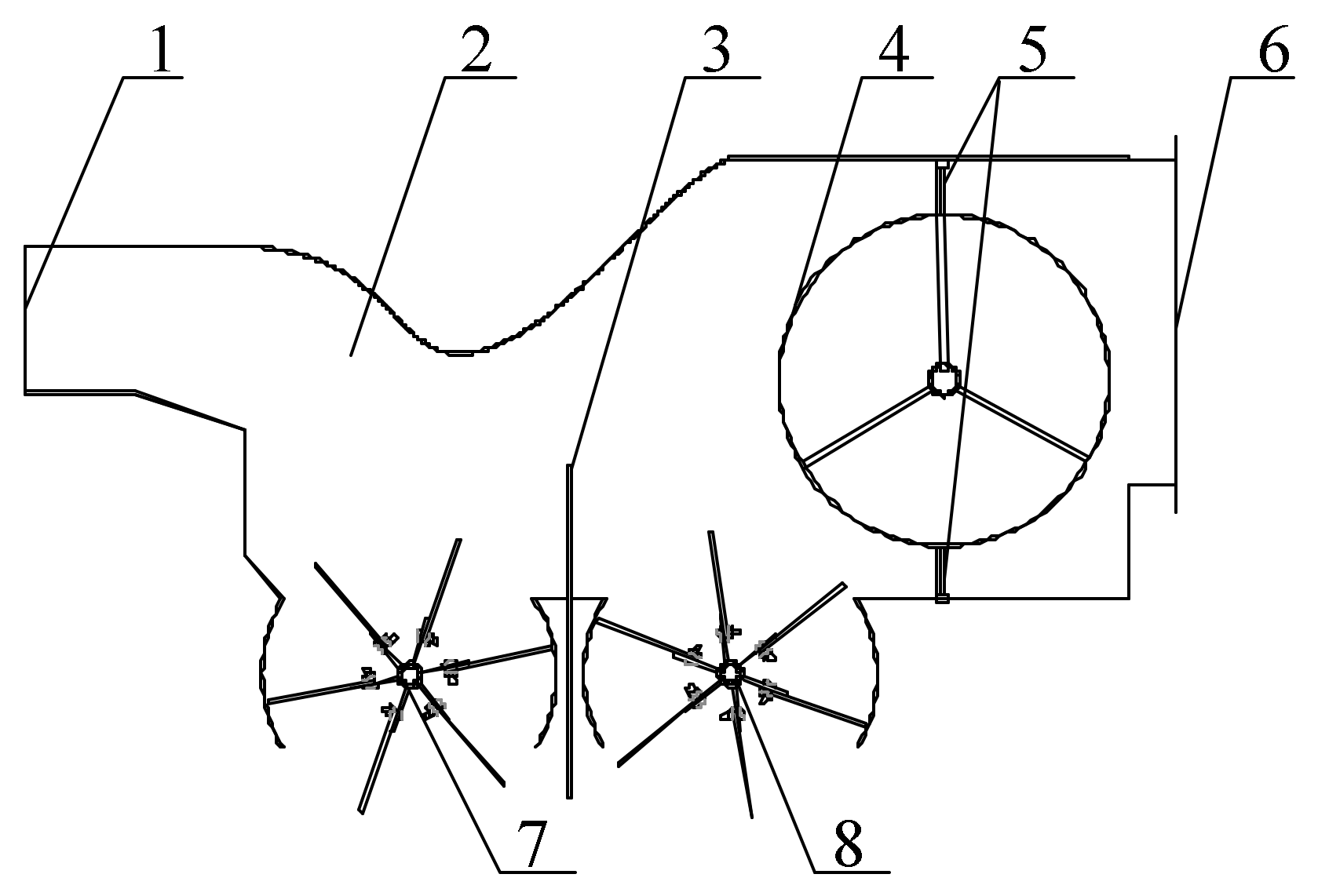

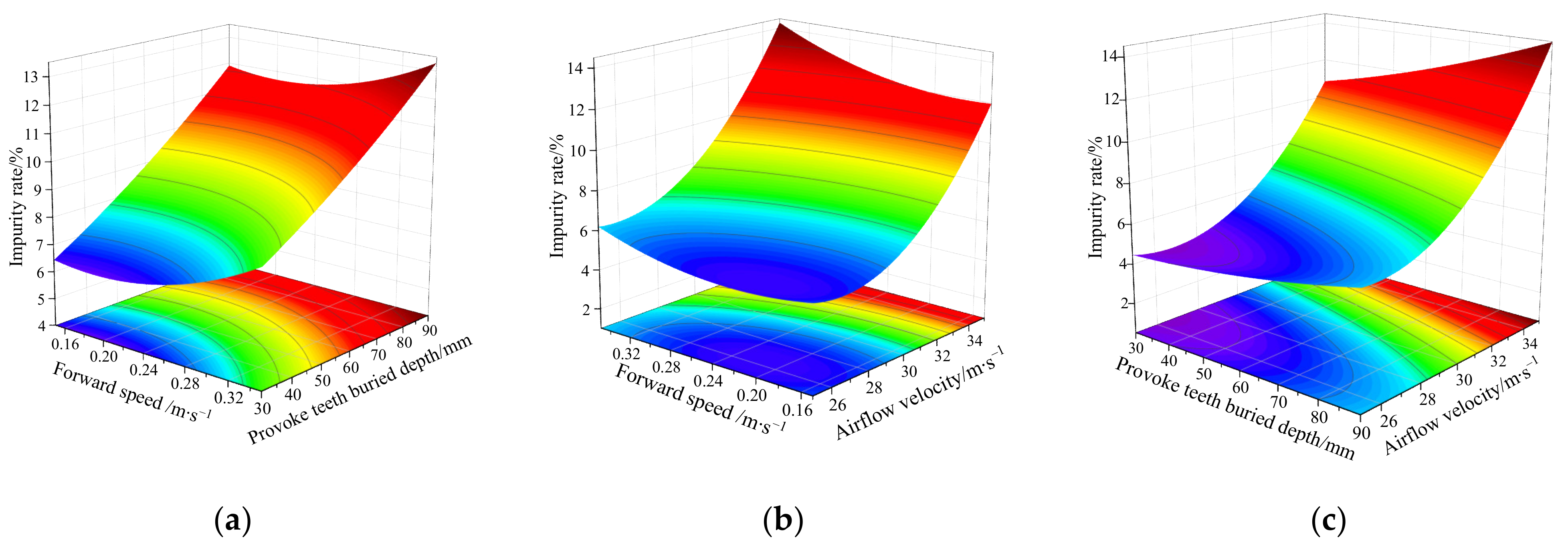
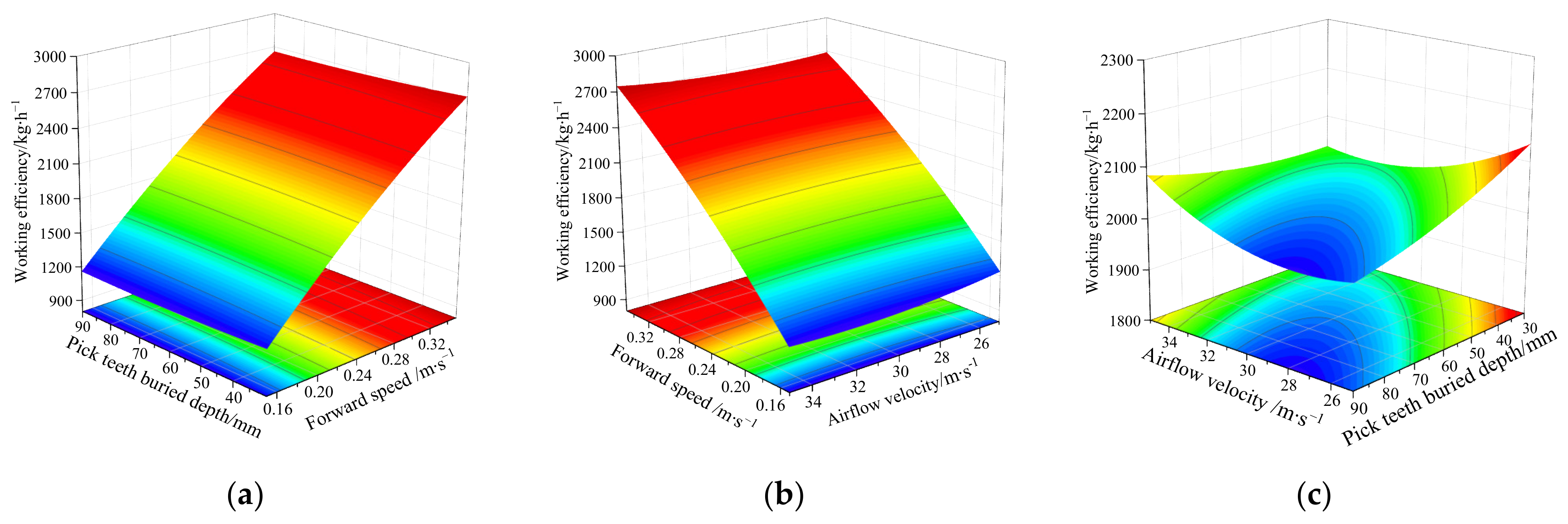
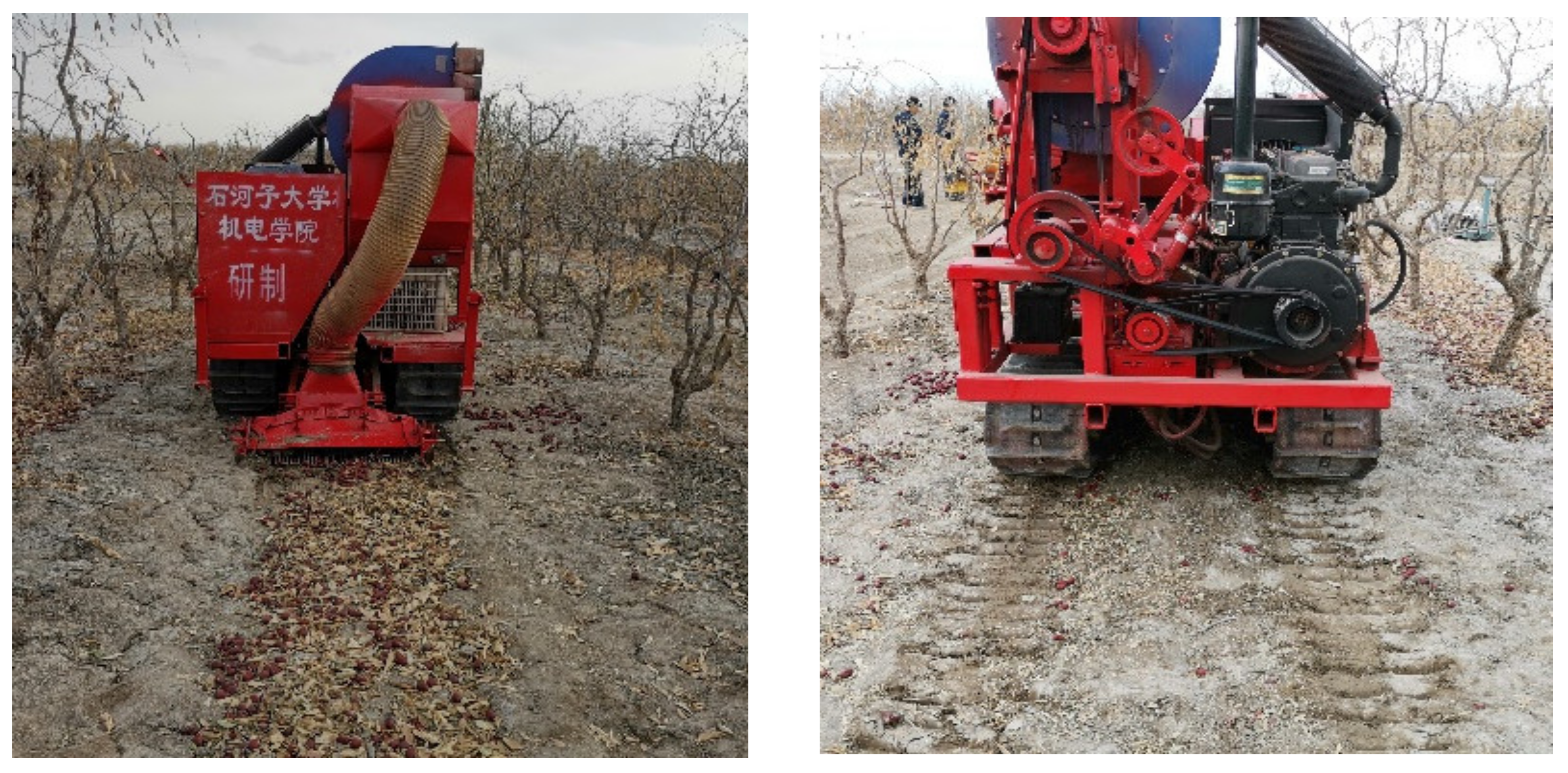
| Items | Values/Type |
|---|---|
| Rated horsepower/kW | 36.8 |
| Unity machine dimensions (Length × width × height)/(mm × mm × mm) | 2840 × 1320 × 2130 |
| Working width/m | 1.0 |
| Drive type | Hydraulic drive |
| Centrifugal fan model | Y5-47 |
| Forward speed/(km∙h−1) | 0–1.5 |
| Levels | Factors | ||
|---|---|---|---|
| Forward Speed X1/m∙s−1 | Provoke Teeth Buried Depth X2/mm | Airflow Velocity X3/m∙s−1 | |
| −1 | 0.25 | 30 | 25 |
| 0 | 0.30 | 60 | 30 |
| 1 | 0.35 | 90 | 35 |
| No. | Factors | Indexes | |||
|---|---|---|---|---|---|
| Forward Speed X1/m∙s−1 | Provoke Teeth Buried Depth X2/mm | Airflow Velocity X3/m∙s−1 | Pickup Rate Y1/% | Impurities Rate Y2/% | |
| 1 | 0.15 | 30 | 30 | 97.15 | 5.7 |
| 2 | 0.35 | 30 | 30 | 96.34 | 7.4 |
| 3 | 0.15 | 90 | 30 | 99.020 | 8.2 |
| 4 | 0.35 | 90 | 30 | 98.59 | 9.5 |
| 5 | 0.15 | 60 | 25 | 98.76 | 5.6 |
| 6 | 0.35 | 60 | 25 | 97.77 | 6.5 |
| 7 | 0.15 | 60 | 35 | 99.97 | 12.4 |
| 8 | 0.35 | 60 | 35 | 99.92 | 14.8 |
| 9 | 0.25 | 30 | 25 | 95.76 | 4.5 |
| 10 | 0.25 | 90 | 25 | 99.37 | 6.6 |
| 11 | 0.25 | 30 | 35 | 98.52 | 11.1 |
| 12 | 0.25 | 90 | 35 | 99.86 | 15.2 |
| 13 | 0.25 | 60 | 30 | 99.34 | 6.4 |
| 14 | 0.25 | 60 | 30 | 99.41 | 6.5 |
| 15 | 0.25 | 60 | 30 | 98.97 | 6.9 |
| 16 | 0.25 | 60 | 30 | 99.33 | 6.7 |
| 17 | 0.25 | 60 | 30 | 99.26 | 6.8 |
| Source of Variance | Pickup Rate | Impurities Rate | Working Efficiency | ||||||
|---|---|---|---|---|---|---|---|---|---|
| Sum of Squares | Means Square | p Value | Sum of Squares | Means Square | p Value | Sum of Squares | Means Square | p Value | |
| Model | 24.00 | 2.67 | <0.0001 ** | 164.50 | 18.28 | <0.0001 | 4.65 × 106 | 5.17 × 105 | <0.0001 ** |
| X1 | 0.65 | 0.65 | <0.0023 ** | 4.96 | 4.96 | 0.0001 ** | 4.60 × 106 | 4.60 × 106 | <0.0001 ** |
| X2 | 10.28 | 10.28 | <0.0001 ** | 14.58 | 14.58 | <0.0001 ** | 2876.61 | 2876.61 | 0.3590 |
| X3 | 5.46 | 5.46 | <0.0001 ** | 114.76 | 114.76 | <0.0001 ** | 24.50 | 24.50 | 0.9304 |
| X1X2 | 0.036 | 0.036 | 0.3095 | 0.040 | 0.040 | 0.4805 | 228.01 | 228.01 | 0.7903 |
| X1X3 | 0.22 | 0.22 | 0.0302 * | 0.56 | 0.56 | 0.0268 * | 4013.22 | 4013.22 | 0.2843 |
| X2X3 | 1.29 | 1.29 | 0.0003 ** | 1.00 | 1.00 | 0.0074 ** | 8807.82 | 8807.82 | 0.1296 |
| X12 | 0.61 | 0.61 | 0.0028 ** | 2.42 | 2.42 | 0.0007 ** | 30762.00 | 30762.00 | 0.0149 * |
| X22 | 5.16 | 5.16 | 0.0026 ** | 0.34 | 0.34 | 0.0677 | 1163.75 | 1163.75 | 0.5522 |
| X32 | 0.21 | 0.21 | 0.0336 * | 24.40 | 24.40 | 0.0001 ** | 8621.32 | 8621.32 | 0.1331 |
| Residual | 0.21 | 0.030 | 0.50 | 0.072 | 20902.54 | 2986.08 | |||
| Lack of fit | 0.093 | 0.031 | 0.4630 | 0.33 | 0.11 | 0.1913 | 15047.36 | 5015.79 | 0.1326 |
| Pure error | 0.12 | 0.029 | 0.17 | 0.043 | 5855.18 | 1463.79 | |||
| Total | 24.21 | 165.00 | 4.67 × 106 | ||||||
| Evaluation Indexes | Optimal Results | Verification Test Results | Relative Errors |
|---|---|---|---|
| Pickup rate | 99.36% | 98.05% | 1.32% |
| Impurities rate | 5.63% | 5.97% | 6.04% |
| Working efficiency | 1672.3 kg∙h−1 | 1591.2 kg∙h−1 | 4.85% |
Publisher’s Note: MDPI stays neutral with regard to jurisdictional claims in published maps and institutional affiliations. |
© 2022 by the authors. Licensee MDPI, Basel, Switzerland. This article is an open access article distributed under the terms and conditions of the Creative Commons Attribution (CC BY) license (https://creativecommons.org/licenses/by/4.0/).
Share and Cite
Shi, G.; Li, J.; Kan, Z.; Ding, L.; Ding, H.; Zhou, L.; Wang, L. Design and Parameters Optimization of a Provoke-Suction Type Harvester for Ground Jujube Fruit. Agriculture 2022, 12, 409. https://doi.org/10.3390/agriculture12030409
Shi G, Li J, Kan Z, Ding L, Ding H, Zhou L, Wang L. Design and Parameters Optimization of a Provoke-Suction Type Harvester for Ground Jujube Fruit. Agriculture. 2022; 12(3):409. https://doi.org/10.3390/agriculture12030409
Chicago/Turabian StyleShi, Gaokun, Jingbin Li, Za Kan, Longpeng Ding, Huizhe Ding, Lun Zhou, and Lihong Wang. 2022. "Design and Parameters Optimization of a Provoke-Suction Type Harvester for Ground Jujube Fruit" Agriculture 12, no. 3: 409. https://doi.org/10.3390/agriculture12030409
APA StyleShi, G., Li, J., Kan, Z., Ding, L., Ding, H., Zhou, L., & Wang, L. (2022). Design and Parameters Optimization of a Provoke-Suction Type Harvester for Ground Jujube Fruit. Agriculture, 12(3), 409. https://doi.org/10.3390/agriculture12030409





